Pallet Changing Machine: How Do Flour Mills Ensure Dust-Free Pallet Swaps?
Flour dust isn't just a mess; it's a serious operational hazard. In a flour mill, a simple task like swapping a pallet can release a cloud of fine particles into the air. This creates a risk of dust explosions, threatens the health of your workers, and can contaminate your final product. Many operators accept this as a necessary evil, but the potential costs of a production halt, a rejected shipment, or a workplace accident are immense. But what if you could transfer a full pallet of flour bags without releasing a single puff of dust? There is a way. Specialized pallet changing machines are engineered to solve this exact problem, turning a hazardous task into a safe, clean, and efficient process.
Flour mills ensure dust-free pallet swaps by using specialized pallet changing machines, often called pallet inverters. These machines work by securely clamping the entire load, including the pallet, within an enclosed chamber. They then rotate the load 180 degrees, allowing the old pallet to be removed from the top and a new one to be placed. The entire process is contained, preventing airborne dust from escaping and ensuring a clean, safe transfer.
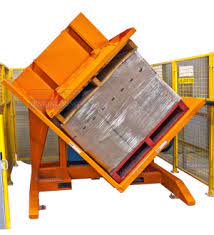
This might sound like a straightforward solution, but the engineering behind it is precise and vital. Throughout my career, from my early days as an engineer to founding my own factory, SHJLPACK, I've seen countless times how a single, well-designed piece of equipment can revolutionize a process. The principles of safe and secure material handling are universal. Whether we are talking about heavy steel coils or delicate bags of flour, the goals are the same: protect the product, keep people safe, and maximize efficiency. Let's dig deeper into why this matters so much in a flour mill and how the technology can be applied to any industry facing similar challenges with dust, contamination, or product integrity.
Why is dust control a critical, non-negotiable factor during pallet exchange in flour mills?
A little bit of dust on the floor might seem like a minor housekeeping issue in some factories. But in a flour mill, that same dust represents a major threat. Ignoring it can lead to catastrophic failures, serious health issues for your team, and financial losses that can cripple a business. This isn't about being tidy; it's about managing a fundamental risk. Understanding the severity of these risks makes it clear why absolute dust control isn't a luxury—it's a core requirement for a safe and profitable operation.
Dust control is critical during pallet exchange in flour mills for three primary reasons: it prevents combustible dust explosions, it protects workers from respiratory illnesses, and it preserves product quality by avoiding contamination. These factors directly impact operational safety, legal compliance, and financial stability.
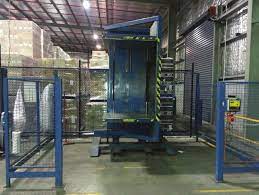
The Hidden Danger: Combustible Dust Explosions
Many people don't realize that organic materials like flour, sugar, or wood can be explosive when dispersed in the air as fine dust. For an explosion to happen, you need five things, often called the "Dust Explosion Pentagon": fuel (flour dust), an oxidizer (air), an ignition source (a spark from machinery), dispersion of dust particles, and confinement (an enclosed building). A manual pallet swap can easily create a dense cloud of dispersed dust, checking off one of the critical conditions. A simple static discharge or a spark from a forklift could provide the ignition. The consequences are devastating. I've heard stories in the industry of entire facilities being leveled by such an event. This isn't just a risk in food processing. In the steel industry, where my experience is rooted, we face similar dangers with metal dusts like aluminum or magnesium. The principle is identical: controlling airborne particles is the first and most important step in preventing a disaster.
The Human Cost: Worker Health and Safety
Beyond the risk of explosion, airborne flour dust is a serious respiratory hazard. Long-term exposure can lead to occupational asthma, sometimes called "baker's asthma," and other chronic lung diseases. This not only causes suffering for employees but also leads to regulatory fines, higher insurance premiums, and lost productivity. A CEO like Javier Morales understands that a company’s greatest asset is its people. Creating a safe work environment is a moral and financial imperative. A process that knowingly exposes workers to airborne hazards is simply not sustainable in the long run. Investing in equipment that contains dust at the source is a direct investment in the well-being of your workforce and the stability of your operation.
The Business Impact: Product Quality and Purity
For a flour mill, product purity is everything. A pallet swap that creates dust also creates opportunities for contamination. Dust can settle on packaging, get into improperly sealed bags, or introduce foreign materials into the product stream. If you need to switch from a wooden pallet, which can harbor moisture, bacteria, and splinters, to a clean, hygienic plastic pallet for shipping, you cannot afford to have dust from the old pallet contaminate the load. A single rejected shipment due to contamination can wipe out the profit from hundreds of others. By ensuring a dust-free transfer, you protect the integrity of your product, uphold your brand's reputation for quality, and avoid costly rejections or recalls.
| Risk Factor | Impact of Uncontrolled Dust (Manual Swapping) | Benefit of Controlled Dust (Pallet Changer) |
|---|---|---|
| Safety | High risk of combustible dust explosion. | Drastically reduces explosion risk by containing dust. |
| Health | Exposure to respiratory hazards, risk of occupational asthma. | Creates a cleaner, safer work environment for employees. |
| Quality | High potential for product contamination, dust, and splinters. | Preserves product purity and meets hygiene standards. |
| Financial | Costs from accidents, fines, rejected shipments, and cleanup. | Lowers operational costs and protects revenue. |
What specific technologies enable a pallet changer to operate without releasing dust?
You have a one-ton load of bagged flour, and you need to move it from a wooden pallet to a plastic one. The traditional way—unstacking and restacking by hand—is slow, labor-intensive, and guarantees a cloud of dust. So how does a machine accomplish this task cleanly? It seems almost like magic, but it’s just smart, practical engineering. Trying to solve this with brute force will only create a bigger mess. The solution lies in containment and gentle handling, principles I’ve applied many times when designing equipment for delicate or heavy materials.
A pallet changer operates without releasing dust by using a combination of three key technologies: a fully enclosed chamber that contains all particles, a gentle clamping system that secures the load without disturbing it, and a smooth, controlled motion (like inverting or pushing) that minimizes agitation of the product.
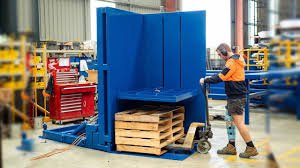
The Principle of Containment: Enclosed Systems
The most effective way to control dust is to never let it escape in the first place. This is the core idea behind most dust-free pallet changers. The machine is designed as a chamber or enclosure. The load, on its original pallet, is moved inside. The doors close, creating a sealed environment. Inside this "box," the entire transfer takes place. This is especially true for pallet inverters, which are the most common solution for bagged goods like flour. The machine clamps the load from the top and bottom, effectively sealing it into a block. Only after the process is complete and the new pallet is in place do the doors open. Any dust that might have been dislodged is trapped inside the machine, where it can be managed through an integrated collection system rather than released into the factory atmosphere.
Gentle Handling: The Art of Clamping and Inverting
If you handle a bag of flour aggressively, it will puff out dust. The same is true for a full pallet load. That's why the clamping and movement must be incredibly gentle. Modern pallet changers don't just slam shut; they use hydraulic or electric systems with adjustable pressure. This allows the operator to set the exact clamping force needed to secure the load without crushing it or shaking it violently. I learned this lesson early in my career while working with steel coils. Too much pressure can damage the edges of the steel, rendering it useless. Too little, and the heavy coil can shift and become a safety hazard. The same precision is required here. The motion of the machine, whether it’s a 180-degree inversion or a push-pull transfer, is smooth and controlled. There are no sudden jerks or drops, which prevents the bags from shifting and releasing dust.
Active Dust Management: Integrated Systems
For environments with extremely strict standards, passive containment can be enhanced with active dust management. High-end pallet changers can be equipped with dust extraction ports. These ports connect to a central dust collection system or a dedicated vacuum with HEPA filters. As soon as any dust becomes airborne inside the chamber, it is immediately captured. Some systems also use ionization bars. These bars neutralize static electricity on the surfaces of bags and packaging. Static can cause dust to cling and then suddenly release when disturbed. By neutralizing it, the dust is less likely to become airborne in the first place. This level of control shows how the technology can be adapted to meet the most stringent requirements, whether for food, pharmaceuticals, or sensitive electronics.
| Technology Type | Dust Control Mechanism | Best Suited For | Key Advantage |
|---|---|---|---|
| Pallet Inverter | Enclosed chamber, top & side clamping, 180° rotation. | Bagged goods (flour, cement), boxes, pails. | Excellent containment and load stability. |
| Pallet Changer (Pusher) | Side walls and a pusher plate slide the load. | Stable, boxed goods, uniform loads. | High speed for in-line automation. |
| Pallet Gripper | Side clamps lift the load from the pallet. | Open-top boxes, rigid items. | Pallet is removed from below, no inversion. |
| Combination Systems | Integrates features like dust extraction ports. | High-purity environments (pharma, food). | Active dust removal for maximum cleanliness. |
How does a dust-free pallet changer impact a flour mill's operational efficiency and costs?
When considering a new piece of equipment, a forward-thinking leader like Javier always asks the most important question: what is the return on investment? It's easy to see a machine as just a capital expenditure. But if you're still relying on manual labor or outdated equipment for pallet swapping, you're already paying for it through hidden costs. You're paying in wasted time, damaged product, cleaning expenses, and safety risks. A modern, dust-free pallet changer isn't a cost center; it's a tool for driving down operational costs and boosting efficiency across the board.
A dust-free pallet changer directly improves a flour mill's efficiency by automating a slow manual process, slashing labor requirements, and reducing product damage. This leads to significant cost savings by eliminating extensive cleanup, preventing product loss, increasing throughput, and creating a safer work environment.
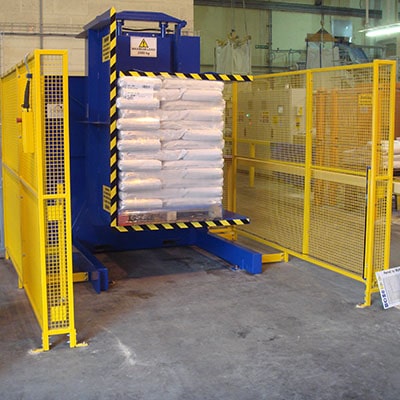
Calculating the ROI: Beyond the Purchase Price
The true value of a pallet changer is revealed when you analyze the costs it eliminates. Let's break it down. Manually swapping a pallet can take two workers 15-20 minutes. A pallet changer can do the same job in about 60-90 seconds with a single operator. If you're swapping 20 pallets a day, you can save several hours of labor. That labor can be reallocated to more value-added tasks. Then there's product damage. Manual handling leads to dropped bags, tears, and spills. A pallet changer handles the load securely, virtually eliminating this waste. I've seen clients reduce product loss in this specific process by over 95%. Finally, consider cleanup. A dusty manual swap requires someone to stop and clean the area afterward. With a dust-free system, that cleanup time is gone. These savings add up quickly, and for many of our clients, the payback period for the machine is often less than 18 months. This directly addresses the goal of reducing overall operational costs.
Boosting Throughput and Uptime
In any production facility, a bottleneck in one area slows down the entire line. The shipping and receiving dock is a common chokepoint. If trucks are waiting because it takes too long to swap incoming goods onto in-house pallets, or to switch finished products to shipping pallets, you are losing efficiency. This is a direct hit to your Overall Equipment Effectiveness (OEE). By turning a 20-minute task into a 90-second one, a pallet changer ensures that your packaging lines can run continuously and that trucks can be loaded and unloaded faster. This contributes directly to the goal of increasing equipment uptime. When Javier aims for 95% effective run time, he knows that small improvements in supporting processes like this are essential to hitting that target.
The Intangible Benefits: Safety and Morale
The financial calculations are compelling, but some of the most important benefits are harder to quantify. A cleaner, safer workplace has a profound impact on employee morale and retention. When you provide your team with the right tools to do their job safely and efficiently, they are more engaged and productive. Furthermore, you drastically reduce the risk of costly workplace accidents and the associated increases in insurance premiums. For a leader building a long-term, sustainable business, creating a culture of safety is not just about compliance; it's a strategic advantage. It demonstrates to your employees, customers, and regulators that you are committed to excellence in every aspect of your operation.
| Cost/Benefit Area | Manual Pallet Swapping | Automated Pallet Changer | Impact |
|---|---|---|---|
| Labor Time | 2 workers, 20 minutes/pallet | 1 operator, 1.5 minutes/pallet | >90% reduction in labor time per pallet |
| Product Waste | ~3-5% damage/spillage rate | <0.5% damage rate | Reduces product loss and waste costs |
| Cleanup Time | 10-15 minutes per swap | 0-1 minute per swap | Frees up staff from non-productive cleaning |
| Throughput | ~3 pallets per hour | ~30 pallets per hour | Eliminates logistics bottlenecks, boosts OEE |
| Safety | High risk of injury and dust exposure | Contained process, ergonomic operation | Drastically improved workplace safety |
What should you consider when choosing a pallet changing machine for a sensitive environment?
You're convinced. You see the value and you're ready to explore a solution. But when you start looking, you find that "pallet changer" is a broad term. There are inverters, pushers, single-level and multi-level systems, and a dozen other variations. Choosing the wrong machine for your specific application is a costly mistake. It might fail to control dust effectively, damage your product, or simply not keep up with your production pace. As an engineer, I believe in a systematic approach. You must clearly define your requirements first, and then find the machine that meets them. This turns you from a buyer into an informed investor.
When choosing a pallet changing machine for a sensitive environment like a flour mill, you must consider four key factors: the machine's specific dust containment capabilities, the construction materials and finish (e.g., stainless steel), the capacity and speed needed to match your line, and the level of automation required to integrate with your existing workflow.
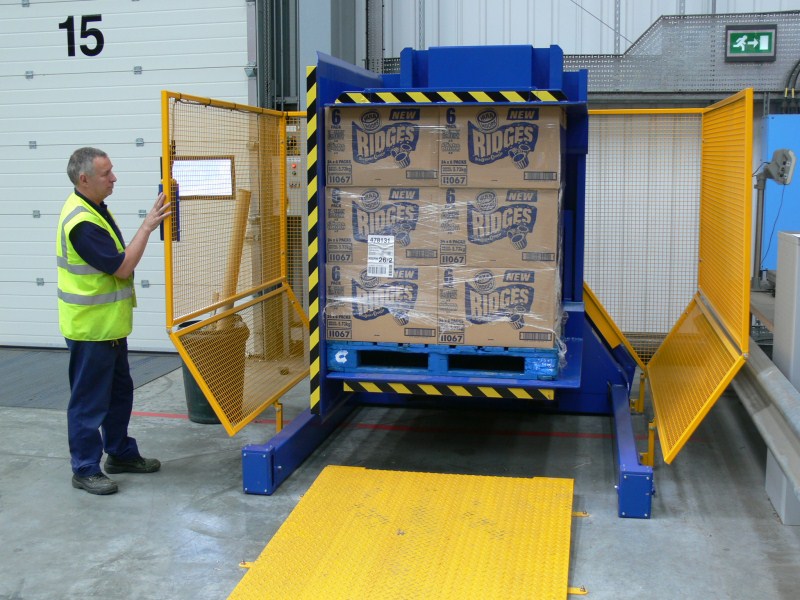
Matching the Machine to Your Product and Load
The first step is to analyze your load. What are you handling? Bags of flour are very different from rigid boxes or open-top drums. Bags are unstable and can shift, making a pallet inverter with full top-and-side clamping the ideal choice. Rigid boxes might be handled well by a faster pusher-style pallet changer. You also need to know the maximum weight and dimensions of your pallet loads. A machine must be rated to handle your heaviest loads with a comfortable safety margin. I learned this principle working with steel coils; a system designed for a 10-ton coil will fail catastrophically with a 15-ton load. Overlooking these basic physical parameters is the most common and dangerous mistake.
Material and Construction: Food-Grade vs. Industrial
Since we are talking about a flour mill, the machine itself must not become a source of contamination. This means looking at the materials and construction quality. For food-grade applications, the machine should be built from stainless steel, particularly any surfaces that might come into contact with the product. Welds should be smooth and continuous, eliminating crevices where dust and bacteria can accumulate. The design should be easy to clean and wash down. This is very different from the requirements for a general industrial environment. In a steel parts factory, the machine needs to be built from heavy-gauge carbon steel to withstand abuse, and its finish must resist oil and grease, but it doesn't need to be food-safe. A good supplier will understand these differences and offer options for different industry standards.
Integration and Automation Level
Finally, how will this machine fit into your workflow? Do you need a standalone unit where an operator with a forklift brings pallets to and from the machine? Or do you need a fully automated, in-line system that accepts pallets from a conveyor, swaps them, and sends them on to the next station without human intervention? This is a critical question for a leader like Javier, who is focused on digitalization and reducing manual touchpoints. A fully automated system can be integrated with your Manufacturing Execution System (MES) or Warehouse Management System (WMS). It can receive commands, execute tasks, and report back data, becoming a smart node in your connected factory. This increases efficiency and provides valuable data for process optimization. The choice depends on your current throughput, budget, and long-term automation strategy.
| Selection Criteria | Your Requirement (Example) | Key Questions to Ask |
|---|---|---|
| Load Characteristics | Bags of flour, 1200 kg max, unstable. | Is the machine suited for bagged goods? What is the max weight and size? |
| Dust Containment | Must be 100% contained, no airborne dust. | Is it a fully enclosed system? Are there options for dust extraction? |
| Material & Finish | Food-grade, stainless steel, wash-down capable. | What grade of stainless steel is used? Are welds smooth? |
| Capacity / Speed | At least 20 pallets per hour. | What is the cycle time? Can it keep pace with my packaging line? |
| Automation Level | Standalone now, but with option for future integration. | Can this machine be integrated with conveyors? What PLC is used? |
| Footprint / Space | Available space is 4m x 5m. | What is the machine's footprint, including operational clearance? |
Conclusion
A dust-free pallet changer is more than a machine; it’s a strategic asset for efficiency, safety, and quality in demanding environments, from flour mills to steel plants.



